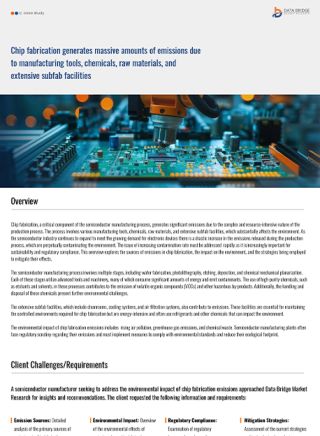Overview
Chip fabrication, a critical component of the semiconductor manufacturing process, generates significant emissions due to the complex and resource-intensive nature of the production process. The process involves various manufacturing tools, chemicals, raw materials, and extensive subfab facilities, which substantially affects the environment. As the semiconductor industry continues to expand to meet the growing demand for electronic devices there is a drastic increase in the emissions released during the production process, which are perpetually contaminating the environment. The issue of increasing contamination rate must be addressed rapidly as it isincreasingly important for sustainability and regulatory compliance. This overview explores the sources of emissions in chip fabrication, the impact on the environment, and the strategies being employed to mitigate their effects.
The semiconductor manufacturing process involves multiple stages, including wafer fabrication, photolithography, etching, deposition, and chemical mechanical planarization. Each of these stages utilize advanced tools and machinery, many of which consume significant amounts of energy and emit contaminants. The use of high-purity chemicals, such as etchants and solvents, in these processes contributes to the emission of volatile organic compounds (VOCs) and other hazardous by-products. Additionally, the handling and disposal of these chemicals present further environmental challenges.
The extensive subfab facilities, which include cleanrooms, cooling systems, and air filtration systems, also contribute to emissions. These facilities are essential for maintaining the controlled environments required for chip fabrication but are energy-intensive and often use refrigerants and other chemicals that can impact the environment.
The environmental impact of chip fabrication emissions includes rising air pollution, greenhouse gas emissions, and chemical waste. Semiconductor manufacturing plants often face regulatory scrutiny regarding their emissions and must implement measures to comply with environmental standards and reduce their ecological footprint.
Client Challenges/Requirements
A semiconductor manufacturer seeking to address the environmental impact of chip fabrication emissions approached Data Bridge Market Research for insights and recommendations. The client requested the following information and requirements:
- Emission Sources: Detailed analysis of the primary sources of emissions in chip fabrication, including manufacturing tools, chemicals, raw materials, and subfab facilities.
- Environmental Impact: Overview of the environmental effects of emissions from chip fabrication, including air pollution, greenhouse gas emissions, and chemical waste.
- Regulatory Compliance: Examination of regulatory frameworks and compliance requirements related to emissions in semiconductor manufacturing.
- Mitigation Strategies: Assessment of the current strategies and technologies for reducing emissions during chip fabrication and improving the environmental sustainability..
- Best Practices: Identification of industry best practices and innovative solutions for minimizing the environmental impact of semiconductor manufacturing processes.
- Technological Innovations: Exploration of emerging technologies and innovations aimed at reducing emissions and enhancing environmental performance in chip fabrication.
- Competitive Landscape: Analysis of key players in the semiconductor industry and their approaches to managing emissions and sustainability.
Databridge Approach/Research Methodology
Data Bridge Market Research conducted a comprehensive study to address the client's needs and provide actionable insights into managing emissions in chip fabrication. The research methodology included:
- Emission Sources Analysis: Detailed investigation into the various sources of emissions in chip fabrication, including the use of tools, chemicals, and the operation of subfab facilities.
- Environmental Impact Review: Examination of the environmental consequences of emissions, focusing on air quality, greenhouse gas effects, and chemical waste management.
- Regulatory Compliance Assessment: Analysis of relevant environmental regulations and standards applicable to semiconductor manufacturing, including compliance requirements and best practices.
- Mitigation Strategies Evaluation: Review of existing methods and technologies for reducing emissions, such as advanced filtration systems, energy-efficient practices, and green chemistry approaches.
- Best Practices Identification: Identification of industry best practices and successful case studies from leading semiconductor manufacturers.
- Technological Innovations Exploration: Analysis of emerging technologies and innovations designed to minimize emissions and improve sustainability in chip fabrication.
- Competitive Analysis: Assessment of how key semiconductor companies are managing emissions and integrating sustainability into their operations.
Outcome and Business Impact
The research conducted by Data Bridge Market Research provided the client with a comprehensive understanding of the emissions associated with chip fabrication and strategies for addressing these challenges. The outcomes and business impact include:
- Strategic Insights: The client gained valuable insights into the sources and impact of emissions, enabling informed decision-making and strategic planning for environmental sustainability.
- Regulatory Compliance: Through understanding regulatory requirements and compliance strategies, the client ensured adherence to environmental standards, reducing the risk of non-compliance.
- Mitigation Strategies: The client identified effective mitigation strategies and technologies for reducing emissions, leading to improved environmental performance and operational efficiency.
- Best Practices Adoption: By learning from the industry best practices, the client implemented successful approaches to minimize emissions and enhance sustainability.
- Innovation Integration: The client explored emerging technologies and innovations, positioning themselves as leaders in environmental stewardship and sustainable manufacturing.
- Competitive Edge: Armed with actionable insights, the client developed strategies to manage emissions proactively, enhancing their reputation and competitiveness in the semiconductor industry.
Conclusion
Managing emissions in chip fabrication is critical for achieving environmental sustainability and regulatory compliance in the semiconductor industry. By addressing the sources of emissions, understanding their impact, and implementing effective mitigation strategies, semiconductor manufacturers can significantly reduce their ecological footprint. Embracing best practices and innovative technologies not only helps in meeting regulatory requirements but also positions companies as leaders in sustainability, contributing to a greener and more responsible semiconductor manufacturing sector.


